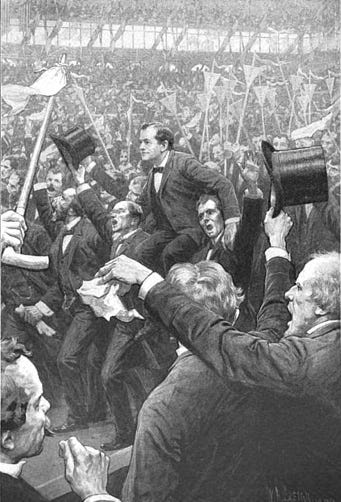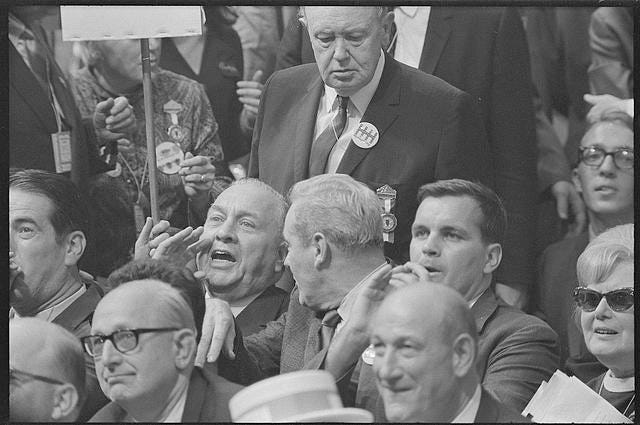Eight Democratic Convention Memories
Best 2 a.m. speech? Best use of Shakespeare? Most daring airplane flight? It's all here.

National political conventions are defined by moments. I’m working on a piece for later in the week on memorable or consequential moments from the 2024 Democratic National Convention. To kick it off, here are eight superlatives based on some of the more memorable, crazy, and consequential moments from past Democratic conventions.
1. Most Famous Speech About the Gold Standard, 1896

In 1896, a fresh-faced, 36-year-old, two-term Congressman from Nebraska gave a rousing populist speech about the economy and, yes, the gold standard. It was a divisive issue at the time and William Jennings Bryan ended his address with these words: "You shall not press down upon the brow of labor this crown of thorns; you shall not crucify mankind upon a cross of gold!"
The delegates were so galvanized they put Bryan on their shoulders and carried him around the convention floor. And then made him the party’s presidential nominee. Bryan’s rise was the first sign that Democrats would later transform themselves from a small government party into one that believed in using the levers of government for progressive goals.
2. The Longest, Most Excruciating Convention Ever Held, 1924
In 1924, Democrats were split into two warring factions: northern urban voters who favored Governor Al Smith of New York for president, and a rural Protestant faction from southern and western states who preferred former Treasury Secretary William McAdoo of California. The McAdoo faction was opposed to immigration, while the Smith supporters included large numbers of Catholic and Jewish immigrants.
It was a recipe for stalemate – and fistfights! And it all played out before the first ever radio audience for a national convention. The battle dragged on for an excruciating 103 ballots. The most dramatic moment of the convention was when the two leading presidential hopefuls, McAdoo and Smith, bowed to the inevitable and jointly withdrew their candidacies. This allowed the delegates to then settle on former Congressman John Davis of West Virginia as the Democratic nominee.
3. Most Daring Airplane Flight, 1932
In 1932, during the Great Depression, the Democrats nominated New York Governor Franklin Roosevelt to run against President Herbert Hoover. After securing the victory, FDR announced plans to fly to Chicago and (in a break from tradition at the time) to accept the nomination in person.
Air travel was new to Americans in 1932, just five years after Charles Lindbergh completed the first solo flight across the Atlantic, and it was seen as risky. But Roosevelt saw an opportunity to stamp himself as a bold candidate, so he made what was then a bumpy, nine hour flight from Albany to Chicago. He was greeted by a cheering crowd of 10,000 people at the airport. FDR then went to the convention and pledged himself “to a new deal for the American people.” The rest is history.
You can see FDR’s famous line about the New Deal at about 5:30 in this video:
4. The First (and only) Voice from the Sewers, 1940
When the 1940 Democratic convention kicked off, Democrats didn’t have a candidate. Because the U.S. appeared on the brink of joining what would become World War II, many in the party favored having Roosevelt run for an unprecedented third term. But FDR hadn’t announced his intentions. At the convention, delegates were given a message from the president saying they were free to vote for any candidate. Then, shortly thereafter, a voice thundered through the convention hall: “We want Roosevelt!” “The world wants Roosevelt!” An FDR celebration erupted on the floor and delegates voted overwhelmingly to again make Roosevelt the party’s nominee.
The voice that had bellowed out support for Roosevelt was that of Thomas Garry, Chicago’s superintendent of sewers, who had a microphone in the basement of the convention hall. Thus, the event that triggered Roosevelt’s nomination soon became known as the “Voice from the Sewers.”
5. Best 2 a.m. Convention Speech, 1948
In 1948, Harry Truman had low approval ratings and was hopelessly behind in the polls against the Republican nominee, Thomas Dewey. Democrats were so down on the president’s chances that some convention delegates waved signs that read: “We’re Just Mild About Harry.” Things didn’t get any better when southern Democrats walked out in a dispute over civil rights and formed their own Dixiecrat party. To top it off, Truman’s acceptance speech didn’t happen till 2 o’clock in the morning, when almost no one was paying attention.
Still, he managed to fire up dejected delegates with a fighting attitude. “I will win this election, and make these Republicans like it, don’t you forget that,” Truman roared (at 1:25 in the above video). It was the first sign of the “Give ‘em hell, Harry!” approach that would mark his now famous whistle-stop train tour across the nation. Truman fought his way back from being 13 points down in the polls in September and stunned the pundits by defeating Dewey on Election Day.
6. Best Use of Shakespeare to Elicit Tears, 1964
The 1964 convention was a poignant convention for Democrats, coming just nine months after President John F. Kennedy’s death from an assassin’s bullet. So at a time when JFK should have been running for re-election, the party gathered to give the 1964 nomination to his successor, Lyndon Johnson. The signature moment was Robert Kennedy’s address in honor of his brother.
RFK was greeted by 12 minutes of applause before he could begin speaking. He then brought tears to the eyes of delegates when he quoted William Shakespeare. “When I think of President Kennedy, I think of what Shakespeare said in Romeo and Juliet: ‘When he shall die, take him and cut him out into stars and he shall make the face of heaven so fine that all the world will be in love with night and pay no worship to the garish sun.’ "
7. Angriest Outburst on National Television, 1968

Nearly everyone knows about the clash between police and antiwar protesters at the 1968 Democratic Convention in Chicago. What is less talked about, however, is the dispute that erupted among Democratic officials when news about the street clashes, tear gas, and blood-stained sidewalks made it into the convention hall.
Connecticut Senator Abraham Ribicoff went off script during a nominating speech to complain about “Gestapo tactics in the streets of Chicago.” In the front of the hall, Chicago Mayor Richard Daley erupted at Ribicoff’s words and unleashed a barrage of obscenities in full view of the television cameras. The mayor’s fusillade was later translated as: “F**k you, you Jew son of a b***h, you lousy motherf***er, go home!”
Yeah, not good. Perhaps Daley was used to smoke-filled rooms and had forgotten about the TV cameras? Or perhaps he just didn’t care? In any case, none of this was helpful to the Democratic nominee, Hubert Humphrey. Richard Nixon was able to present himself as a stabilizing force against the turbulence and won the presidency.
8. Most Famous Keynote Address, 2004
Similar to 1896, the 2004 Democratic Convention saw a national career launched by a single speech. The Democratic star who emerged this time was Barack Obama, then a Senate candidate from Illinois who electrified the party with his keynote address.
“There is not a liberal America and a conservative America -- there is the United States of America,” declared Obama. “There is not a Black America and a white America and Latino America and Asian America -- there's the United States of America.”
Obama’s keynote was one of the more consequential convention speeches in history, as it made him a national figure and paved the way for his presidential run four years later.
What will be some of the more indelible moments from this year’s convention? Stay tuned.




Thanks for attaching clips. Those were great